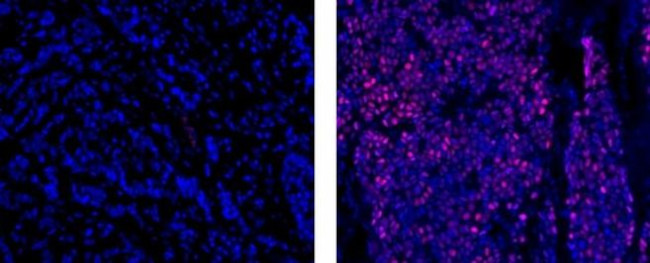Search Thermo Fisher Scientific
Invitrogen
Progesterone Receptor Monoclonal Antibody (KMC912), eFluor™ 660, eBioscience™
FIGURE: 1 / 1
Progesterone Receptor Antibody (50-9764-80) in IHC (P)

Product Details
50-9764-80
Species Reactivity
Host/Isotype
Recommended Isotype Control
Class
Type
Clone
Conjugate
Excitation/Emission Max
Form
Concentration
Purification
Storage buffer
Contains
Storage conditions
Shipping conditions
RRID
Product Specific Information
Description: This KMC912 monoclonal antibody reacts with human progesterone receptor (PgR, PR), a member of a superfamily of nuclear receptors that are ligand-dependent transcriptional regulators. The human PgR exists in alpha and beta forms, 94 kDa and 120 kDa respectively. In most human cells, the alpha and beta forms are expressed at similar levels and predominately form heterodimers. Progestin binding to PgR causes a conformational change, allowing dissociation of bound chaperone proteins and subsequent dimerization with either PgRa or PgRb. Following activation, dimerized PgR can directly bind to DNA through progestin response elements (PRE) leading to chromatin remodeling and subsequent downregulation or transcription of the target gene.The PgR plays a key role in controlling gene expression in breast, uterine, brain, and cardiovascular tissue during development. The presence of the PgR in breast tissue is indicative of improved survival and a better response to endocrine therapy. In breast and endometrial cancer progression, a predominance of either the alpha or beta form occurs, suggesting disregulation in the PgRa:PgRb ratio is an early event in cancer. In cases of ductal carcinoma in situ and invasive ductal carcinoma, there is predominance of the alpha form while in uterine cancer a loss of either form is common.
Applications Reported: This KMC912 antibody has been reported for use in intracellular staining followed by flow cytometric analysis, immunohistochemical staining of formalin-fixed paraffin embedded tissue sections, microscopy, and immunocytochemistry.
Applications Tested: This KMC912 antibody has been tested by immunohistochemistry of formalin-fixed paraffin embedded human tissue using low pH antigen retrieval and can be used at less than or equal to 20 µg/mL. This KMC912 antibody has also been tested by immunocytochemistry of methanol-fixed and permeabilized human cells and can be used at less than or equal to 20 µg/mL. This KMC912 antibody has also been tested by intracellular staining followed by flow cytometric analysis of BT474 cells using the Foxp3/Transcription Factor Staining Buffer Set (Product # 00-5523-00) and protocol. Please refer to Best Protocols: Protocol B: One step protocol for (nuclear) intracellular proteins located under the Resources Tab online. This can be used at less than or equal to 1 µg/test. A test is defined as the amount (µg) of antibody that will stain a cell sample in a final volume of 100 µL. Cell number should be determined empirically but can range from 10^5 to 10^8 cells/test.
It is recommended that the antibody be carefully titrated for optimal performance in the assay of interest.
eFluor® 660 is a replacement for Alexa Fluor® 647. eFluor® 660 emits at 659 nm and is excited with the red laser (633 nm). Please make sure that your instrument is capable of detecting this fluorochome.
Excitation: 633-647 nm; Emission: 668 nm; Laser: Red Laser.
Filtration: 0.2 µm post-manufacturing filtered.
Target Information
The progesterone receptor (PR) is a member of the steroid family of nuclear receptors. The PR mediates the physiological effects of progesterone, which plays a central role in reproductive events associated with the establishment and maintenance of pregnancy. PR is found as a 94 kDa protein (Form A) or a 120 kDa protein (Form B) due to the use of alternative translation initiation sites. PR-B is the transcriptionally active form and is responsible for activating genes for the maintenance of the endometrium, maintenance of pregnancy, and inhibition of ovulation. PR-A is identical to PR-B except for a 165 amino acid deletion at the N-terminus. This deletion exposes a 140 amino acid inhibitory domain (ID) that acts as a repressor of steroid hormone transcriptional activity. In its inactive state, PgR forms a multiprotein complex which includes heat shock proteins and immunophins. Upon binding of progesterone hormone to its receptor, there is a conformational change that allows dimerization and binding of the receptor to progesterone response elements (PRE) sequences, resulting in activated transcription. A Null mutation in the PGR gene leads to pleiotrophic reproductive abnormalities.
For Research Use Only. Not for use in diagnostic procedures. Not for resale without express authorization.
How to use the Panel Builder
Watch the video to learn how to use the Invitrogen Flow Cytometry Panel Builder to build your next flow cytometry panel in 5 easy steps.
References (0)
Bioinformatics
Protein Aliases: Nuclear receptor subfamily 3 group C member 3; PR; Progesterone receptor
Gene Aliases: NR3C3; PGR; PR
UniProt ID: (Human) P06401
Entrez Gene ID: (Human) 5241

Performance Guarantee
If an Invitrogen™ antibody doesn't perform as described on our website or datasheet,we'll replace the product at no cost to you, or provide you with a credit for a future purchase.*
Learn more
We're here to help
Get expert recommendations for common problems or connect directly with an on staff expert for technical assistance related to applications, equipment and general product use.
Contact tech support

